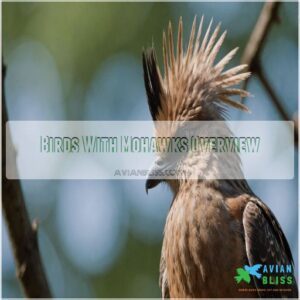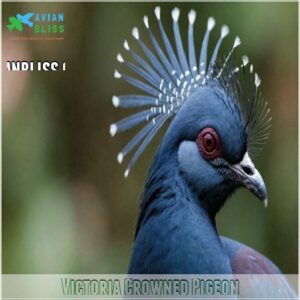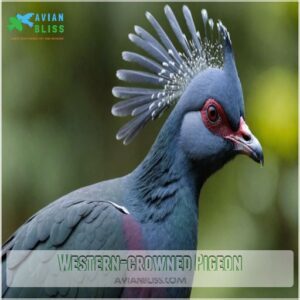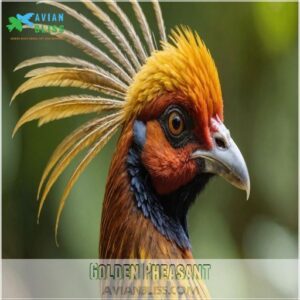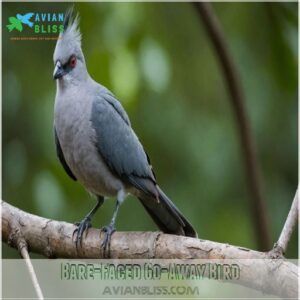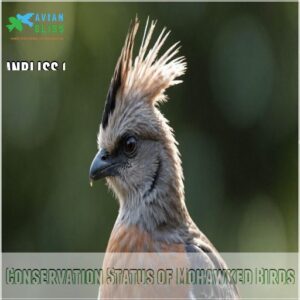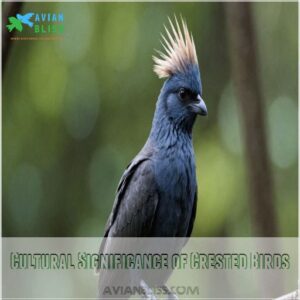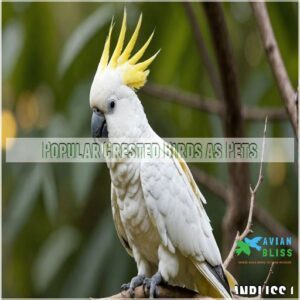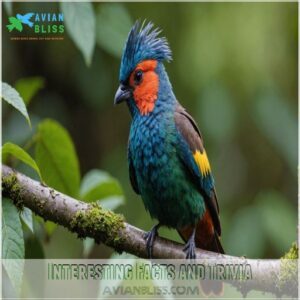This site is supported by our readers. We may earn a commission, at no cost to you, if you purchase through links.
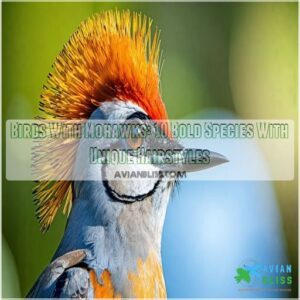
Birds with mohawks definitely take the cake.
The Palm Cockatoo flaunts a stylish black crest, while the Victoria Crowned Pigeon shows off feathers that look like a royal crown.
Even the Dalmatian Pelican sports a tuft that could make a rock star jealous.
These impressive crests aren’t just for show—like a flashy suit, they help in courtship rituals and intimidation.
Imagine a mohawk being nature’s way of saying, "I’m bold and proud!"
Curious about how these birds maintain their stylish looks?
There’s more plumage glam waiting for you.
Table Of Contents
- Key Takeaways
- Birds With Mohawks Overview
- Types of Birds With Mohawks
- Habitat and Distribution
- Functions of Mohawks in Birds
- Conservation Status of Mohawked Birds
- Mohawk Maintenance and Health
- Cultural Significance of Crested Birds
- Observing Birds With Mohawks in The Wild
- Popular Crested Birds as Pets
- Interesting Facts and Trivia
- Frequently Asked Questions (FAQs)
- What birds have mohawks?
- Why do some birds use Mohawks?
- Are Mohawks good looking birds?
- How do Mohawk birds get their name?
- Do birds Rock a Mohawk?
- What does a Mohawk look like on a bird?
- Where Do Royal Flycatchers Live?
- What Is The Bird With A Yellow Mohawk?
- What Bird Has An Orange Mohawk?
- What is a bird with a mohawk called?
- What is a small bird with a little mohawk?
- What are the little blue birds with mohawks?
- What are the red birds with mohawks?
- How do mohawk styles differ among species?
- Can mohawk size predict a birds age?
- Are mohawks seasonal or year-round features?
- Do mohawks affect a birds flight ability?
- How do birds groom their mohawks?
- Conclusion
Key Takeaways
- You’ll find that birds with mohawks use their crests not just for style but for communication, courtship displays, and intimidation, making them essential tools for survival.
- These birds, like the Palm Cockatoo and Victoria-crowned Pigeon, showcase a diverse range of mohawk styles, each serving unique purposes such as attracting mates or warding off threats.
- Spotting these crested wonders in their natural habitats, from rainforests to urban areas, offers exciting birdwatching opportunities, while also highlighting the challenges like habitat loss they face.
- Conservation efforts play a crucial role in protecting these stylish birds, including the whooping crane, a species that has made a remarkable recovery from a mere 20 birds in the 1940s to around 600 today, thanks to conservation efforts like wetland management programs, ensuring they continue to thrive despite threats like climate change and poaching.
Birds With Mohawks Overview
Among birds, crests—often referred to as mohawks—serve fascinating purposes, from attracting mates to warding off rivals.
You’ll find these unique hairstyles vary widely, from the palm cockatoo’s dramatic crest to the more subtle tufts on songbirds, each with a splash of color and personality.
Definition of Avian Crests
Ever wondered why some birds wear feathered helmets?
These fancy headpieces are called avian crests, resembling nature’s own mohawk.
From simple tufts to elaborate plumes, bird crests come in diverse shapes and colors.
They’re not just for show—they need proper crest care to stay vibrant.
Whether for flaunting beauty or style, avian crests add flair to the bird kingdom.
Evolutionary Purpose of Mohawks in Birds
You might wonder why some birds wear a wild mohawk.
These crests didn’t just appear for fashion’s sake.
They’ve evolved as key tools for survival and communication.
Picture a bird using its mohawk to signal a mate or ward off predators.
It’s not just about looking cool; it’s built into their feathers’ DNA, enhancing their chances in life’s big game.
Diversity of Crest Shapes and Sizes
Picture a world where birds sport mohawks, and crests come in all shapes and sizes, adding flair to their plumage.
Some birds flaunt delicate, lace-like crests, while others boast bold, striking plumes.
With around 100 bird species featuring avian crests, these natural accessories serve various functions in bird behavior.
- Intricate beauty: Victoria-crowned pigeons display elaborate, fan-like crests.
- Sleek simplicity: Palm cockatoos wear smooth, defined crests.
- Whimsical variations: Eurasian hoopoes reveal crests for dramatic displays.
Types of Birds With Mohawks
You’re about to meet a fascinating group of birds that sport mohawks, each with its own unique style, from the flashy Palm Cockatoo to the elegant Victoria-crowned Pigeon.
These feathered fashionistas flaunt their crests not just for looks, but to communicate, attract mates, and sometimes even intimidate rivals.
Palm Cockatoo
Now, let’s meet a true rockstar of the bird world: the Palm Cockatoo.
This impressive cockatoo boasts a striking, smoky black mohawk. Its distinctive red cheek patches add to its bold look.
You’ll find these colorful birds in Australia, Indonesia, and Papua New Guinea.
Palm Cockatoo sounds are quite unique, and their diet consists mainly of seeds and fruits.
Their unique dependence on the spruce budworm population for successful reproduction, as seen in the Cape May Warbler, can significantly impact their breeding habits and conservation status are important to understand for bird identification.
Learning about Palm Cockatoo habitat helps protect these magnificent creatures.
Victoria-crowned Pigeon
Victoria-crowned pigeons, with their striking lacy crests, truly steal the show.
Residing in New Guinea’s lush habitats, these large birds with mohawks use their head feathers to impress potential mates.
As you’re capturing their beauty, remember they’re much more than a pretty face.
Their maroon chests and red eyes make them a fascinating example of bird species with distinctive features.
Western-crowned Pigeon
Admiring the Western-crowned Pigeon is like spotting a royal guest in New Guinea’s forests.
Its striking crest speaks volumes, a true icon among birds with mohawks.
With a diet of fruits and seeds, it’s well-suited to lush habitats.
Despite their grandeur, these pigeons face threats from habitat loss, but dedicated conservation efforts aim to protect their unique plumage and species.
Golden Pheasant
Picture the Golden Pheasant with its dazzling golden mohawk, a true forest royalty.
These birds thrive in Chinese woodlands, and their diet includes grain, leaves, and bugs for a balanced meal.
They’re not just beautiful but elusive too, making them a prized catch for birdwatchers.
Quick facts:
- Habitat: Woodlands
- Diet: Omnivore
- Breeding: Ground nests
- Conservation: Least concern
- Behavior: Shy yet colorful
Eurasian Hoopoe
The Eurasian Hoopoe, with its striking mohawk of brown and black-tipped feathers, is a birdwatcher’s delight.
You’ll find it showing off in Europe, Asia, and Africa.
Its distinctive "hoo-hoo" vocalizations break the silence, guiding keen ears during migration.
With a diet of insects and a knack for symbolism, this bird’s a living example of nature’s flair and mystery!
Red-crested Turaco
From the Eurasian Hoopoe’s striking plumage, we swoop to the Red-crested Turaco.
This bird flaunts dazzling red head feathers, with its vibrant rusty-red cap atop its head, reminiscent of red-headed sparrows. This bird flaunts dazzling red head feathers, living in lush African woodlands.
It’s not just about looks:
- Diet: Fruits and leaves make up its menu.
- Calls: Its unique vocalizations can turn heads.
- Breeding: Monogamous pairs nest in dense forests.
Turacos are true wildlife gems!
Bare-Faced Go-Away Bird
While the red-crested turaco boasts a regal crest, the bare-faced go-away bird prefers a more subtle yet impactful style.
Found in Africa, this bird uses its mohawk to signal mates and issue distinctive calls.
Sadly, habitat threats loom over these quirky creatures.
Their mimicry behavior might amuse you, but conservation efforts are critical to guarantee their ongoing presence in the wild.
Crested Duck
Observing crested ducks? Their "mohawk" isn’t a true mohawk like some birds with punk rock haircuts; it’s more of a subtly raised crest.
Crested duck domestication has led to variations in crest size, but its purpose remains a mystery. Some speculate it aids in bird mating displays, while others believe it’s simply a fun quirk of evolution.
Crested duck care is similar to other domestic ducks. Breeding crested ducks requires careful selection for desired crest characteristics. Think of it as a feathered fashion statement!
Crested Partridge
Meet the crested partridge, where these tiny birds flaunt their stylish mohawks.
Their forest homes in Asia face threats, yet these bold birds endure.
You’ll find them indulging in a diet rich in seeds and fruits.
Here’s why they fascinate:
- Unique calls
- Intriguing breeding behavior
- Conservation efforts underway
Dalmatian Pelican
Imagine being a Dalmatian pelican, flaunting a crest that’s truly a standout in the avifauna world.
This bird doesn’t just sit pretty—its breeding habits and nest building are essential for chick development.
Dalmatian pelican enthusiasts can even find unique toys inspired by the species, such as those available at Dalmatian Pelican Toys.
Yet, there are conservation concerns.
As ecosystems change, the bird diversity faces challenges, making the Dalmatian pelican a symbol of bird richness and abundance.
Habitat and Distribution
You’ll find birds with mohawks in a variety of scenic spots, from the lush tropical rainforests and temperate woodlands to expansive grasslands and bustling urban areas.
Whether you’re exploring the savannas or spotting them in local parks, these stylish birds seem to have a knack for adapting to different environments, much like teenagers sporting the latest hair trends!
Tropical Rainforests
As you explore the vibrant world of birds with mohawks, imagine this: tropical rainforests buzzing with life.
Curassows, with their striking mohawks, roam this dense habitat, showcasing rainforest mohawk diversity and tropical crest evolution.
These rich ecosystems support bird communication and brilliant camouflage.
Protecting such environments helps guarantee that bird wildlife, like the wood ducks and towhees, thrives in harmony.
Temperate Woodlands
Moving from the vibrant tropical rainforests to temperate woodlands, you’ll find a different world for woodland birds.
These serene settings, rich in wildlife and nature, host species thriving through enchanting seasonal changes.
Bird lovers, take note: habitat loss endangers some of these mohawk-clad beauties.
Keep your binoculars ready for some prime birding opportunities and unforgettable encounters.
Grasslands and Savannas
Picture the sweeping grasslands and savannas, where birds with mohawks thrive.
These habitats offer open spaces, rich with life and a few threats.
Savanna birds have adapted mohawks to endure fire impacts and grazing effects, making them marvels of nature.
Bird hobbyists cherish these areas for bird sanctuaries and reserves, ensuring bird protection and preservation continues.
Urban and Suburban Environments
You might be surprised to learn that some crested birds thrive in cities and suburbs. These urban wildlife adapt surprisingly well.
Think of the resourceful tufted titmouse, often seen at suburban bird feeders, which can be attracted with specialized feeders like those available at Mohawk bird feeder retailers. Their mohawk adaptations aren’t just for looks; they play a role in communication and attracting mates, even in noisy environments.
- Habitat challenges, like limited nesting sites, are overcome by using human-made structures.
- Bird breeding success in urban areas depends on food availability and safety from predators.
- Some flycatchers even find city life advantageous, finding plenty of insects near streetlights.
Functions of Mohawks in Birds
You’ve probably noticed that birds with mohawks don’t just wear these flashy styles for fun; they play key roles in communication, whether attracting mates or scaring off rivals.
These feathery crests can transform from a glamorous courtship display to an intimidating defense mechanism quicker than you can say “punk rock bird,”
ensuring each bird stays noticed and understood in the avian social scene.
Courtship Displays and Mate Attraction
Imagine wandering through the vibrant habitats of mohawked birds.
It’s here, amidst tall grasses and lush canopies, the magic unfolds.
Birds use their mohawks for courtship displays and mate attraction, flaunting mohawk size, crest color variations, and engaging in ritual dances.
These extravagant shows, paired with unique mating calls, turn your ordinary forest into a dazzling dance floor.
Territorial Defense Mechanisms
A bird’s mohawk isn’t just for show; it’s a shield for their space.
These crests can make rivals think twice.
You’ll see some sneaky tactics at play:
- Display postures: A raised crest looks larger and more intimidating.
- Wingspans: Extending feathers create a formidable silhouette.
- Vocalizations: Unique calls add oomph to their stance.
Don’t forget, these birds mean business!
Communication Among Flock Members
Mohawks aren’t just about style; they’re a buzzing part of a bird’s chatter.
As you watch birds gathered in a flock, their mohawks say a lot.
These crests, with vocalizations and body language, help in broadcasting alarm calls, maintaining the social hierarchy, and structuring the flock, often conveying emotional state and social status through crest displays and emotional state.
It’s nature’s way of keeping the conversation lively and the group organized!
Intimidation of Predators and Rivals
Crested birds don’t just wear their hairstyles for show—they use them to intimidate predators and rivals.
When faced with threats, these extravagant Mohawks are powerful tools. Here’s what they offer:
- Mohawk size creates a larger visual presence.
- Threat displays with crest flair.
- Predator defense through confusion.
- Rival competition and dominance.
Their evolution truly is a crest above the rest!
Conservation Status of Mohawked Birds
You might be surprised to learn that some of these stylish birds are facing the threat of extinction.
From habitat loss to conservation efforts, understanding the challenges these feathered fashionistas face is vital to keeping their mohawks ruffling in the wild.
Threatened and Endangered Crested Birds
So, those flashy mohawks aren’t just for show!
Sadly, some of these birds are struggling.
Crested bird conservation is essential.
Habitat protection helps, but poaching and climate change impact their numbers.
Captive breeding programs offer hope, giving these feathered friends a fighting chance.
It’s a tough situation, but we can make a difference.
Let’s work together to protect these amazing creatures!
Habitat Loss Impacts on Mohawked Species
Imagine this: mohawk-topped birds, dazzling and unique, now threatened by habitat loss.
These avian rockstars face shrinking homes due to unchecked deforestation and urban creep.
Human impact? It’s hitting hard, nudging these vibrant creatures closer to species decline.
You’d think they’d launch a reforestation concert!
Watching the population trends, one wonders how long until their charm is just a memory.
Conservation Efforts for Crested Birds
Regarding saving crested birds, you’ve got to think big.
Habitat fragmentation, like a neighborhood chopped by new roads, puts them at risk.
Captive breeding programs and conservation funding play key roles in ensuring their survival.
Get involved in community engagement to tackle ecological threats.
Together, we can give these feathery rock stars the spotlight they deserve.
Mohawk Maintenance and Health
To keep a bird’s mohawk looking sharp, you’ll need to focus on regular grooming and a healthy diet.
Just like humans feel more confident after a haircut, these birds benefit from proper crest care, helping them stay stylish and healthy year-round.
Crest Feather Care Techniques
Caring for a bird’s mohawk is like tending to a royal crown—it needs attention!
Start with crest trimming to keep it neat.
1. Feathers thrive on natural oils—encourage preening.
2. Watch the diet impact; a nutritious menu boosts feather health.
3. The molting cycle offers a chance for fresh feathers to bloom, ensuring vibrant crests for all seasons.
Seasonal Changes in Mohawk Appearance
See those mohawks on birds? They transform with the seasons.
Mohawk color changes, molting cycles, and winter camouflage make crests dynamic.
During the breeding season, these changes help birds stand out or blend in.
Imagine your hairstyle shifting with the weather!
| Season | Mohawk Change | Example Effect |
|---|---|---|
| Breeding | Color intensifies | Attracts mates |
| Molting | Feather regrowth | New texture |
| Winter | Camouflage adapts | Better concealment |
Impact of Diet on Crest Health
Ever wondered how a bird’s diet affects its mohawk?
Just like a balanced meal helps you grow strong, a bird needs the right vitamins and minerals for lush crest feather growth.
Nutritional deficiencies might dull those vibrant colors.
Imagine a Golden Pheasant with a faded crown!
Diet impacts not just molting, but also feather health and color.
Mohawk Regrowth After Molting
Many birds experience a complete mohawk makeover during their molting cycle, which typically lasts around 2 to 3 weeks, depending on the species.
New feathers emerge gradually, often within a few weeks.
A healthy diet rich in protein and essential nutrients supports robust crest growth, similar to how budgies require a high-quality nutritional diet for a successful molt.
Patience is key; it takes time for the full, fabulous mohawk to return.
Cultural Significance of Crested Birds
You mightn’t realize it, but birds with crests, often resembling mohawks, have been significant symbols across various cultures.
From Indigenous traditions to modern fashion and art, these flamboyant feathers have left their mark on national emblems, literature, and even hairstyles.
Symbolism in Indigenous Cultures
Imagine a bird’s crest like a crown, connecting sky and earth, buzzing with symbolism.
In many indigenous cultures, these crested birds—totemic birds—carry spiritual meaning, often seen as messengers or symbols of wisdom and power.
Their striking mohawks aren’t just feathers; they’re vibrant threads weaving into tribal art and cultural narratives, enriching the community’s spiritual tapestry.
Representation in Art and Literature
While birds with mohawks symbolize freedom and flair in indigenous tales, you’re likely to find them coloring the pages of novels and dazzling art displays, too.
These crested wonders don’t just perch prettily; they strut through stories and paintings, embodying joy and mystery.
Their flamboyant crests spark creative imaginations, making each artistic depiction unique and unforgettable.
Use in National Emblems and Logos
Crested birds have long been celebrated in national emblems and logos, weaving their cultural significance into powerful symbols.
Their unique crest designs inspire logo creators to blend elegance with strength, making bird-based branding a hit.
From fierce eagles in flags to vibrant parrot motifs, these avian icons evoke freedom and resilience, echoing nature’s bold statement across various cultures and organizations.
Influence on Fashion and Hairstyles
Look at those who’ve embraced Mohawk trends, from punk rock bands to celebrities strutting bird-inspired cuts.
Birds like the Palm Cockatoo and Red-Crested Turaco have mohawks that scream personality, much like your favorite stars!
Their crests influence fashion with bold lines and colors, sparking new celebrity styles and demonstrating how nature leaves its mark on our everyday wardrobes.
Observing Birds With Mohawks in The Wild
When you’re out in the wild, spotting a bird with a mohawk can feel like discovering a punk rocker at a classical concert.
Whether in a lush rainforest or a bustling city park, these fancy-feathered creatures stand out, making birdwatching both an exciting and rewarding adventure.
Birdwatching Tips for Crested Species
So, you’re ready to spot some seriously stylish birds? Great! Grab your birdwatching gear, including binoculars and a camera.
Understanding crested bird behavior is key; patience is essential, especially when observing behaviors like courtship displays.
Mastering habitat identification helps you find your favorite mohawk birds.
Remember, good photo tips mean getting close without disturbing them. Enjoy the show!
Best Locations for Spotting Mohawked Birds
Want to spot birds with mohawks? Head to birdwatching hotspots like Australia for the charming Cockatiel or Africa to see the majestic Grey Crowned Crane.
Understand their habitat preferences and global distribution—rainforests, savannas, or even bustling cities.
Keep seasons in mind; migration can impact sightings.
Connect with local guides for insider tips and the best chances to observe these crested wonders.
Photography Techniques for Capturing Crests
Catching those wild bird mohawks in a photo takes some practice.
First, 1. Timing: Snap when light highlights their crests at dawn or dusk.
2. Equipment: A telephoto lens is your best friend.
3. Patience: Wait for the right moment; the bird’s expression matters.
With the right mix of these elements, you’ll get shots worthy of a magazine cover!
Citizen Science Projects Focusing on Crested Birds
Getting involved in citizen science projects lets you play a key role in tracking crested birds.
With habitat monitoring and data collection, you contribute to conservation efforts.
By observing these birds, you gain fascinating insights.
It’s like catching a glimpse of nature’s art gallery.
Here’s a quick guide:
| Project Name | Location | Species Focus |
|---|---|---|
| Crest Watchers | North America | Northern Cardinal |
| Mohawk Monitors | Australia | Palm Cockatoo |
| Bird Crest Mapper | New Guinea | Victoria Crowned Pigeon |
| Feathered Friends | Asia | Crested Partridge |
| Mohawk Movements | Africa | Grey Crowned Crane |
Popular Crested Birds as Pets
If you’re thinking about adding a crested bird to your family, the charismatic Palm Cockatoo and the lively Sulphur-crested Cockatoo might just make perfect companions.
These feathered friends require special care, including a balanced diet and plenty of social interaction, to keep their stunning mohawks in tip-top shape.
Palm Cockatoo as Pets
Palm Cockatoos are like the rock stars of the bird world, flaunting their smoky mohawks.
Their unique personality and intelligence make them intriguing pets, but they require commitment.
Training tips include patience and consistency, as they thrive on interaction.
Make sure you have ample space for housing requirements, and consider their diet with fresh fruits.
Potential problems involve their strong beaks and loud calls.
Sulphur-crested Cockatoo as Pets
A real character in the bird world, the sulphur-crested cockatoo matches the palm cockatoo in personality.
Their intelligence shines as they mimic sounds and learn tricks, keeping you entertained for decades given their long lifespan.
Their spacious needs can be met with a suitable Cockatoo cage setup.
Training these feathery comedians takes patience, but the payoff is worth it.
With a balanced diet and mental stimulation, they’ll be your lifelong animated companions.
Care and Feeding of Crested Birds
Someone once said, "A bird in the hand is worth two in the bush," but caring for crested birds requires dedication.
Their well-being hinges on proper care.
You’ll need to provide a suitable diet, spacious housing, and monitor their health.
Breeding requires specialized knowledge.
Molting is a natural process, but it’s important to provide support.
- A balanced diet is essential for vibrant feathers.
- Adequate space prevents stress and promotes healthy behavior.
- Regular vet checkups are essential for early disease detection.
- Understanding their molting cycle helps you anticipate needs.
- Researching breeding requirements helps guarantee successful reproduction.
Interesting Facts and Trivia
You might think keeping a bird as a pet means teaching it to talk or whistle, but owning a crested bird offers even more pizzazz.
When you look beyond their stunning hairstyles, you’ll find delightful tidbits. Did you know some birds use their Mohawk colors for mimicry? It’s like wearing the trendiest hat at a fashion show!
Similarly, birds like the bald eagle, with their impressive physical characteristics, have also become symbols of strength and patriotism in North America, as evident in their role as the national symbol of the United States since 1782.
Not all these stylish birds live in comfort; some are endangered species, facing challenges like habitat loss.
Here’s a quick peek at what makes these avian wonders tick:
| Feature | Example Bird | Fun Fact |
|---|---|---|
| Mohawk Colors | Victoria-crowned | Crest helps in mate attraction |
| Crest Evolution | Palm Cockatoo | Can modify crest for communication |
| Endangered | Philippine Eagle | Fewer than 400 pairs exist in the wild |
Mohawk grooming is important for these feathery fashionistas—keeping their look sharp is essential!
Frequently Asked Questions (FAQs)
What birds have mohawks?
Imagine spotting a bird with a cool mohawk!
From the Palm Cockatoo’s smoky black crest to the vibrant Golden Pheasant’s striking yellow crown, these feathered friends flaunt their styles across continents like Australia and New Guinea.
Why do some birds use Mohawks?
Birds flaunt mohawks for several reasons, like attracting mates or sending a powerful message.
Imagine a crest as their feathered megaphone, catching attention or signaling confidence, much like flaunting a snazzy hairstyle to impress others.
Are Mohawks good looking birds?
Like warriors donning mighty helmets, birds with mohawks often captivate the eye, blending fashion and function.
These feathered styles serve to attract mates, communicate, or intimidate.
Whether striking or peculiar, they definitely stand out in nature’s parade!
How do Mohawk birds get their name?
You’ll find that "mohawk" refers to the prominent crest of feathers on their heads.
It’s a descriptive name, like calling a fluffy dog "Fuzzy."
These birds didn’t choose their names; we did!
Do birds Rock a Mohawk?
Did you know the Eurasian Hoopoe unfurls its orange mohawk during mating rituals?
Birds don’t just sport these stylish crests for show; they use them for communication, attracting mates, and sometimes even intimidating rivals.
It’s bird fashion!
What does a Mohawk look like on a bird?
Imagine a bird sporting a funky mohawk!
Feathers shoot straight up, often colorful or patterned.
These stylish crests help birds communicate or attract mates, adding a dash of flair to their feathery ensemble, just like rock stars!
Where Do Royal Flycatchers Live?
Royal Flycatchers strut their stuff in the vibrant rainforests of Central and South America.
They’re like fashionistas among birds, showing off their colorful crests while living it up in lush habitats stretching from Mexico to Argentina.
What Is The Bird With A Yellow Mohawk?
Over 10,000 bird species flaunt unique traits, but the Golden Pheasant truly shines with its striking yellow mohawk.
This vivid critter, often found in Chinese forests, uses its colorful crest to attract mates, creating a charming spectacle.
What Bird Has An Orange Mohawk?
The Eurasian Hoopoe flaunts an orange mohawk, perfect for snagging attention.
This bird uses its colorful crest to communicate and intimidate, making it a striking sight.
You’ll often find hoopoes in Europe, Asia, and Africa.
What is a bird with a mohawk called?
Birds with mohawks have unique names.
Think of the Palm Cockatoo or Victoria-crowned Pigeon.
These fancy feather styles help them stand out, attract mates, or even communicate.
Imagine having a mohawk that says, "Look at me!
What is a small bird with a little mohawk?
Many small birds sport mini-mohawks!
Think tufted titmice, for example.
Their crests aren’t huge, but they’re definitely there, adding a touch of spunk to these tiny flyers.
It’s all about perspective!
What are the little blue birds with mohawks?
Imagine spotting Victoria-crowned pigeons fluttering about; they’re those striking, large bluish-gray birds with elegant lacy crests, resembling blue mohawks.
You might catch them parading around New Guinea, showing off feathers that would impress even Queen Victoria herself!
What are the red birds with mohawks?
When life gives you lemons, spotting birds with vibrant plumage, like the Northern Cardinal, whose bold red coloration differs greatly from the more subdued palette of the Red Robin, read about their color differences. Spot a red bird with a mohawk like the Northern Cardinal or the Red-crested Turaco.
Their vivid red feathers and distinctive crests make them stars of backyards and woodlands alike.
How do mohawk styles differ among species?
Birds flaunt mohawks in diverse styles: peacocks have lace-like crests, while cockatoos sport spiky tufts.
Each style serves a purpose—mating, communication, or intimidation—making these feathered hairstyles both functional and fabulous across various species.
Can mohawk size predict a birds age?
Mohawk size in birds doesn’t usually indicate their age since crests primarily serve purposes like communication and attraction.
Mohawk size is not a reliable indicator of age in birds.
Instead, you’d better check for other age markers, like feather condition and overall size changes over time.
Are mohawks seasonal or year-round features?
Picture a bird’s mohawk as its eternal crown, a year-round accessory.
It doesn’t change with seasons, although birds might flaunt it more during certain times, like mating season, to attract attention or communicate with others.
Do mohawks affect a birds flight ability?
You might wonder if mohawks impact a bird’s flying abilities.
Generally, they don’t.
These feathery styles, while making quite the fashion statement, are lightweight and don’t hinder aerodynamics or speed in flight.
It’s all about style!
How do birds groom their mohawks?
Did you know over 25% of bird species preen regularly?
Birds use their beaks, carefully cleaning and arranging each feather, including those stylish mohawks!
They’ll also use their feet for hard-to-reach spots.
It’s a daily ritual, keeping their plumage pristine.
Conclusion
A world without birds with mohawks would be like skies without rainbows—missing the splash of style and flair these feathered icons bring!
These birds, from the bold Palm Cockatoo to the regal Victoria-crowned Pigeon, show us that nature’s fashion is both diverse and purposeful.
Whether strutting in urban parks or hidden in dense forests, their crests captivate and convey messages from courtship to communication.
Keep your eyes peeled; these avian mohawks are worth watching!

